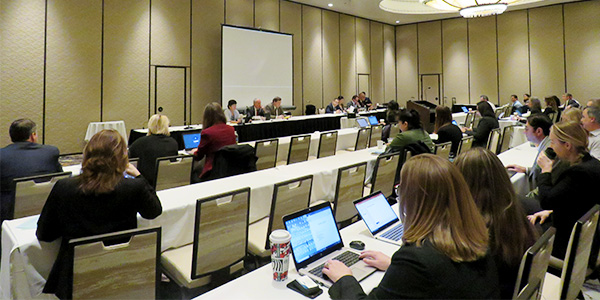By Hudson Sangree
LAS VEGAS — Stakeholders in CAISO’s Western Energy Imbalance Market last week reacted coolly to a proposal by Utah’s Deseret Power Electric Cooperative to tighten the market’s rules on transmission feasibility.
Deseret made the proposal during a Dec. 3 Regional Issues Forum panel that explored the differences between resource sufficiency and resource adequacy.
Don Tretheway, CAISO’s senior adviser for market design, said the difference is mainly timing.
“Resource adequacy is ensuring, on a forward basis, that you’ve contracted with sufficient steel in the ground so that you can meet your monthly peaks, your annual peaks. It’s really about … making sure that you can serve your load,” Tretheway said. “Resource sufficiency evaluations [are] a series of tests to ensure that someone’s not inappropriately leaning on an energy imbalance market [to meet demand] on a short-term basis.”
Four tests are conducted several times per hour to ensure an entity has met the agreed-upon threshold for participating in the EIM, Tretheway said, including a transmission feasibility test to determine if a participating entity has sufficient transmission capacity or unresolved transmission congestion. A balancing test determines if an entity’s actual load is within 5% of its base-schedule load for that hour, according to the ISO. A capacity test makes sure an entity has sufficient resources to meet its projected load, and a ramping test looks at ramping flexibility in 15-minute increments.
Clay MacArthur, vice president of power marketing at Deseret, said the EIM should adopt rules to address a loophole in the feasibility test that may allow entities to inappropriately spread around (socialize) the costs of congestion.
The transmission feasibility test, he said, determines if electricity can reach load within a particular balancing area. “It’s just a simple test that looks for congestion on the system,” he said.
The EIM’s design allows for the socialization of unforeseen congestion constraints within a given hour, but MacArthur said that’s not the problem. The feasibility test, he said, doesn’t account for an entity that knows it has transmission constraints but fails to report them ahead of time.
“They can just submit a base schedule that ignores that,” MacArthur told RTO Insider.
If an EIM entity knows of transmission constraints and includes them as part of its base schedule, it will bear the costs, MacArthur said. But if it doesn’t report its pre-existing constraints, the EIM’s market design can inadvertently shift the costs of those constraints to other load-serving entities across the market via neutrality charges. “If my schedules were balanced and somebody came into the hour with a known transmission infeasibility, why should I pay a share of that?” MacArthur said. “I can’t do anything to mitigate that.”
He proposed tariff language requiring EIM entities to “ensure that all financially binding base schedules submitted to the market operator are feasible and do not violate any known or expected transmission constraints.”
If they do, then the EIM would be required to notify the entity and give it a chance to revise its base schedule. If the entity doesn’t, then it may be subjected to congestion offset charges, the proposal says.
MacArthur called for greater market transparency by releasing suffiency test results and neutrality charges to market participants. That would allow for an objective evaluation of whether the market has a problem, he said.
MacArthur said he just meant “pass or fail” and “ones and zero,” without divulging privileged information.
His proposal prompted sometimes heated discussion between panelists and audience members, though not much agreement with MacArthur’s proposal.
Kelcey Brown, PacifiCorp’s manager of market and analytics, acknowledged her company had been a party to the problem described by MacArthur during the EIM’s early years, after starting operations in 2014, when utilities were still going through a learning curve. But she said the company put safeguards in place to ensure it wouldn’t happen again. She said she didn’t know of other examples.
“I’m not sure this is as big of an issue as Clay is referring to,” Brown said.
Petar Ristanovic, CAISO vice president of technology, agreed. “I don’t understand your concern, sir,” he told MacArthur.
MacArthur said the only way to determine the problems’ extent would be to have the information he’d asked for.
For about 30 minutes, panelists and audience members held a back and forth, trying to clarify or argue points.
At the end of the panel, Pam Sporborg, the new chair of the RIF, thanked the panelists “for a lively discussion,” and the audience responded with hearty applause.
MacArthur said that as the transmission customer of an EIM entity, Deseret couldn’t formally request further proceedings. CAISO could do that on its own, he said, or Deseret could file with FERC.
“That may be the only way to get it addressed,” he said.


